Market Trend: Definition, Types, Identification, Uses, and Importance
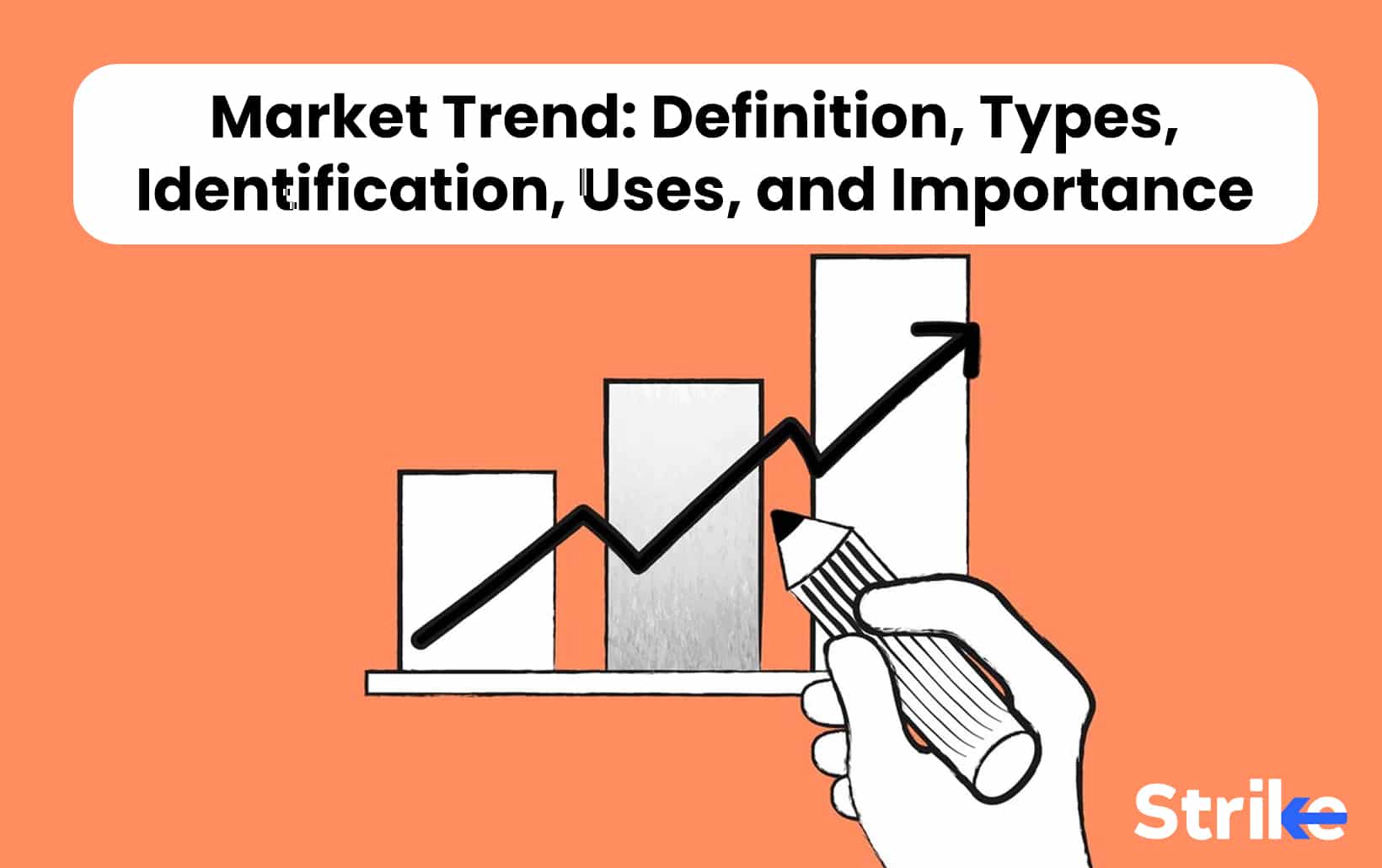
Market trends are the general direction that a financial market is moving over a period of time. Identifying emerging trends and analyzing their strength, sustainability, and potential reversals is crucial for traders to make informed decisions. Market trends types include based on timeframe – primary trends last over a year, secondary trends correct for weeks or months against the primary trend, intermediate trends capture market swings over days or weeks, and minor trends depict daily fluctuations.
Technical analysis through price action, indicators, and patterns is used to spot trend direction and reversals. Upward sloping trendlines and higher highs/lows indicate uptrends while downward slopes and lower highs/lows signal downtrends. Factors like economic data, sentiment, supply/demand dynamics, and events can affect trend changes. Traders look to enter trades in the overall market trend direction shown on higher timeframe charts like daily or weekly.
Trade management through stop losses, profit targets, and risk/reward ratios is key. Analyzing market trends allows traders to capitalize on emerging opportunities and manage trades based on momentum and probabilities.
What is a market trend?
A market trend is the general direction that a market is moving in over a period of time. Market trends can be upward, downward, or sideways, depending on various economic factors influencing supply and demand. Identifying market trends allows investors and analysts to make more informed decisions when buying or selling financial assets.
How many types of Market Trends are there?
The types of trends in market include primary trends, secondary trends, secular trends, intermediate trends, and minor trends. Below are more headline.
1. Primary Trends
The primary trend is the long-term trend, which typically persists for 1 year or more. A consistent upward or downward movement distinguishes the trend. In addition, it symbolizes the general market sentiment.
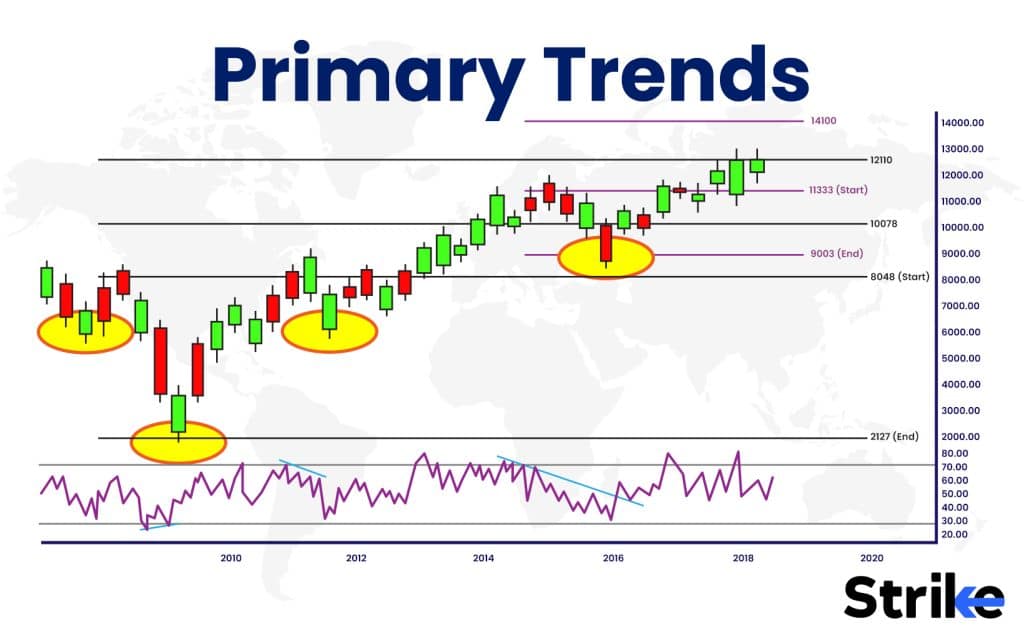
The primary trend, often indicative of a bull market or bear market, serves as a barometer for the entire economy and reflects the performance of the large businesses listed on the stock exchange. Below is how a primary trend will look in a chart during a bull market or bear market.
2. Secondary trends
The secondary trend is a corrective movement that persists for a period of several weeks to several months. It is a counter-trend movement that moves in the opposite direction of the primary trend. Nevertheless, this trend is a temporary correction or pullback, rather than a definitive reversal of the primary trend.
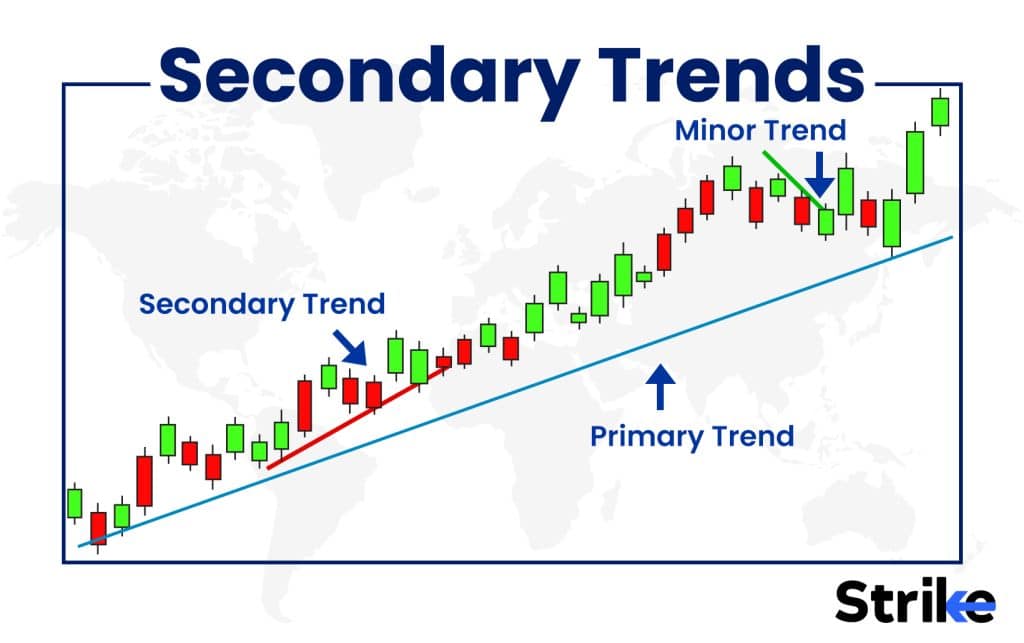
A short-term reverse movement, which is commonly referred to as a market correction, occurs when specific investors and traders begin to book profits during the primary uptrend. This market correction is merely a secondary trend. Consider this a minor counter-reaction to the more significant market movement. For instance, corrections in the bull market indicate that investors and traders are reserving their profits, while corrections in the bear market indicate that specific investors and traders are accumulating and generating recoveries in the bear market. The duration of the secondary trend can range from a few weeks to several months.
3. Secular Trends
Secular trends refer to market activities that are not influenced by short-term factors or that unfold over long time horizons. Throughout the forseeable future, a secular trend or market is expected to persist in its current trajectory.
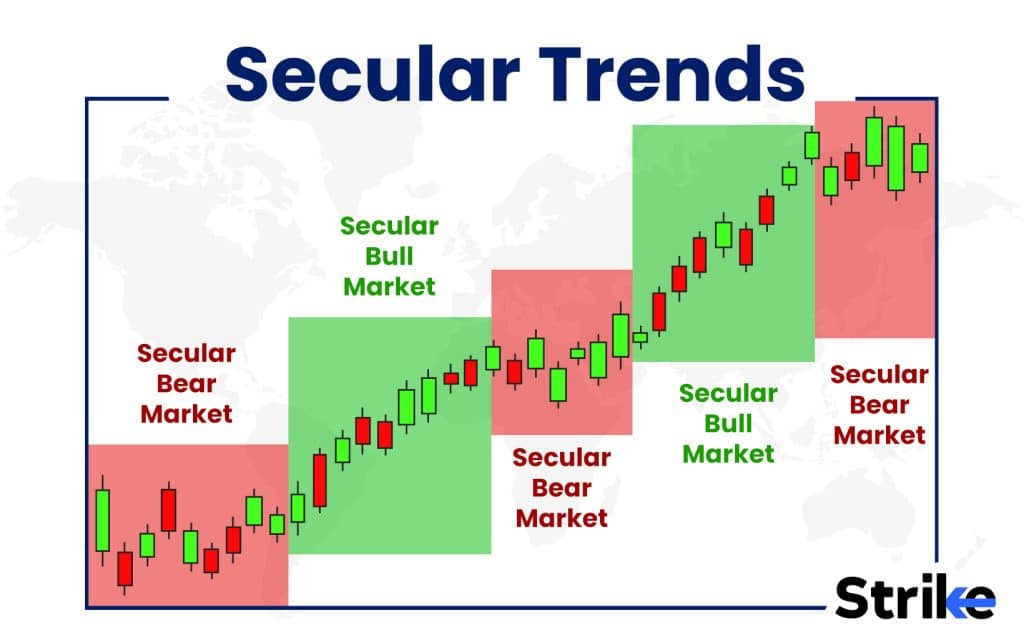
Secular market activities are those that take place over long time horizons or are unaffected by short-term factors. A secular trend or market is one that is anticipated to persist in its current trajectory for an extended period of time. The market’s boom and bust cycles have an impact on secular trends, which are different from cyclical trends. Technology companies like Netflix and eCommerce leaders like Amazon are classified as secular stocks. The direction of the secular movement of a long-term trend can be neutral (flat), positive, or negative. Take a look at the below graph.
4. Intermediate Trends
Intermediate trends are shorter-term trends that last for days or weeks. They are influenced by current events, economic reports, earnings announcements, and other news that impacts investor psychology over the short-term. Intermediate trends capture the back-and-forth, up-and-down price movements as prices fluctuate within the larger primary trend. Traders look to trade intermediate trends for quicker profits compared to position trading the primary trend. However, intermediate trends carry more noise and uncertainty. Trends formed on daily or weekly charts are considered intermediate trends. Breakouts, pullbacks, continuations, reversals–these patterns unfold over days or weeks as intermediate trends emerge.
But volume and momentum may be inconsistent as speculative trading causes choppy price swings. Intermediate trends still follow technical analysis principles like support, resistance and chart patterns.
Yet they require faster trade execution before the trend rapidly changes. Their volatile, reactionary nature makes defining clear intermediate trends more difficult. Any news or data can quickly shift investor sentiment and alter the trend. It takes experience to distinguish between random volatility and a true emerging trend. With so much noise, intermediate trends are prone to whipsaws and false breaks. This necessitates wider stops and more active risk management.
Traders may utilize faster moving averages to identify new intraday or daily trends early. Overall, trading intermediate trends well demands patience, discipline and adaptability. Markets are news-driven over weeks versus fundamentally-driven over months and years. The dominance of algorithmic trading also amplifies short-term volatility.
Despite these challenges, adroit traders can capitalize on intermediate trends for expedited gains. The key is properly confirming new trends, defining risk levels, and reacting nimbly to shifts while adhering to a sound trading plan.
5. Minor Trends
Minor trends are brief, only lasting a few days to weeks. They represent the short-term fluctuations in price as supply and demand constantly shift. Minor trends oscillate within the larger primary trend. They capture the market’s day-to-day volatility and noise. Trading the minor trends requires agility to capitalize on small, quick price moves. These micro trends are prone to whipsaws as the price reverses temporarily. Minor trends depict the market’s constant state of flux in the ultra short-term. Without a persistent driving force, minor trends flow more randomly.
This makes clear patterns hard to detect with much uncertainty. Traders can get chopped up attempting to trade every wiggle and tick. Minor moves often retrace themselves quickly as randomness prevails. The lack of follow-through results in frantic back-and-forth price action. Minor trends form and fade fast, not lasting long enough to establish real direction. Intraday charts best display minor trends unfolding in real-time. Very short-term cycles, oscillations and rotations occur continuously.
Day traders may attempt to profit from minor trend breakouts and reversions. But unpredictability makes this trading style risky without discipline. The stochastic nature of minor trends shows the market’s endless micro supply and demand dynamics. News and events can accelerate minor trend momentum temporarily. However, the impact quickly vanishes without lasting power.
Valid support and resistance or trend lines are difficult to plot. Indicators like RSI, MACD, stochastics attempt to capture minor shifts. Still volume and momentum often lag price in these fleeting moves.
How to identify a Market Trend in Stock Market?
Both technical and fundamental analysis is used to recognize market trends in stock markets. Technical indicators like trendlines, price action, RSI, and moving averages are popular tools to visualize the trend.
Fundamental metrics like earnings growth can also define bullish or bearish trends. Drawing trendlines on price charts connects a series of highs and lows over time. Upward sloping trendlines reveal potential support levels for an uptrend. Downward slopes act as resistance for downtrends. The angle and number of touches determine the trendline’s validity. Clear violations signal a trend change.
Price action analyzes raw price data to detect impulsive and corrective moves. Higher highs and lows depict uptrends. Lower highs and lows signal downtrends. Candlestick patterns can identify continuations or reversals. RSI measures overbought and oversold levels to gauge trend strength. Readings above 70 indicate overbought conditions, while below 30 is oversold. Both signal potential reversals ahead. Moving averages smooth out price fluctuations to better visualize the trend.
Crossovers of short and long-term moving averages hint at trend changes. SMAs simply average closing prices over fixed lookback periods. EMAs weight recent prices more heavily for responsiveness. Comparing the slope of major moving averages defines the overall trend. Rising moving averages confirm upturns, falling MAs signal downturns. Fundamental factors like revenue and earnings growth also demonstrate economic trends.
Consistent positive growth points to bullish stock trends, while declines suggest bearishness. Comparing actual results to estimates reveals positive or negative surprises. Management guidance indicates forward outlooks. Combining fundamental analysis and technical analysis creates a robust view of emerging trends. Traders should focus on longer time frames for major trends and use technical analysis on shorter time frames for intermediate trends while incorporating fundamental analysis to understand the underlying factors driving these trends.
How to Trade using Market Trend?
To trade using market trend, traders first need to identify the predominant trend on the timeframes they trade. Using technical analysis, traders can spot uptrends, downtrends or sideways ranges through trendlines, moving averages, RSI levels and price action.
Once the trend is determined, traders can then look to enter trades in the direction of the trend. In an uptrend, traders would seek long opportunities and aim to buy dips in the stock. Good entry points may come from pullbacks to key support levels or moving averages. Stop losses can be placed below recent swing lows.
Profit targets can be set at psychologically significant round numbers or using a risk/reward ratio like 1:2. In a downtrend, traders would watch for shorting opportunities and look to sell rallies. Entries may come from bounces into resistance or breakdowns from key levels. Stops are placed above recent highs and targets at supports. The most critical rule is to only trade in the direction of the major trend. Traders should avoid countertrend trades which have lower probabilities. Managing risk is crucial when trend trading.
Using wider stops to accommodate volatility and avoiding excessive leverage prevents blowups. Letting winners run to ride the trend maximizes profits. Having the patience and discipline to stay with a trend until definitive signs of reversal is key for all types of traders. Good trend traders remain adaptable to shifts in market character, a trait that distinguishes them from other types of traders.
Which factors can affect Market Trend?
Below are key factors that impact and cause shifts in overall market trends. Some of the most influential drivers are listed below.
Supply and Demand
The most fundamental economic force underpinning trends is the dynamic between supply and demand of a stock or asset. Changes in availability or interest will cause prices to trend up or down.
Government Policy
Fiscal, monetary, or regulatory decisions made by central banks and governments move markets dramatically. Interest rates, taxes, tariffs, stimulus etc. all change economic landscapes.
Market Sentiment
The overall psychology and speculative mania of investors will propel trends strongly. Fear and greed are difficult to quantify but move markets powerfully.
Economic Conditions
Macro conditions like GDP growth, unemployment, wages, housing data, retail sales etc. provide insights into the health of the economy to inform market trends.
Black Swan Events
Extremely rare and unpredictable events can suddenly and severely disrupt markets, triggering swift trend changes. Geopolitics, natural disasters, pandemics are examples.
Understanding these major external forces and how they shift is essential for traders. Adapting trading strategies quickly to changing market trends driven by these dynamics is what separates successful traders from the rest.
Why should you analyze Market Trends?
Analyzing market trends is crucial for traders to identify opportunities, plan profitable trades, and manage risk. Determining the current trend, its strength, and when shifts occur allows traders to trade in the direction of momentum in the stock market. Understanding stock market trends also provides valuable insights into changing economic and social dynamics influencing asset prices.
How to know Market Trend before market opening?
Pre-market trading activity provides clues on market sentiment and potential upcoming trends. Observing index futures, economic data releases, news headlines, and price movements in foreign markets that are already open allows anticipation of opening direction. Pre-market volume, price action, and volatility indicate if overnight sentiment will carry into the regular session.









 Previous Article
Previous Article



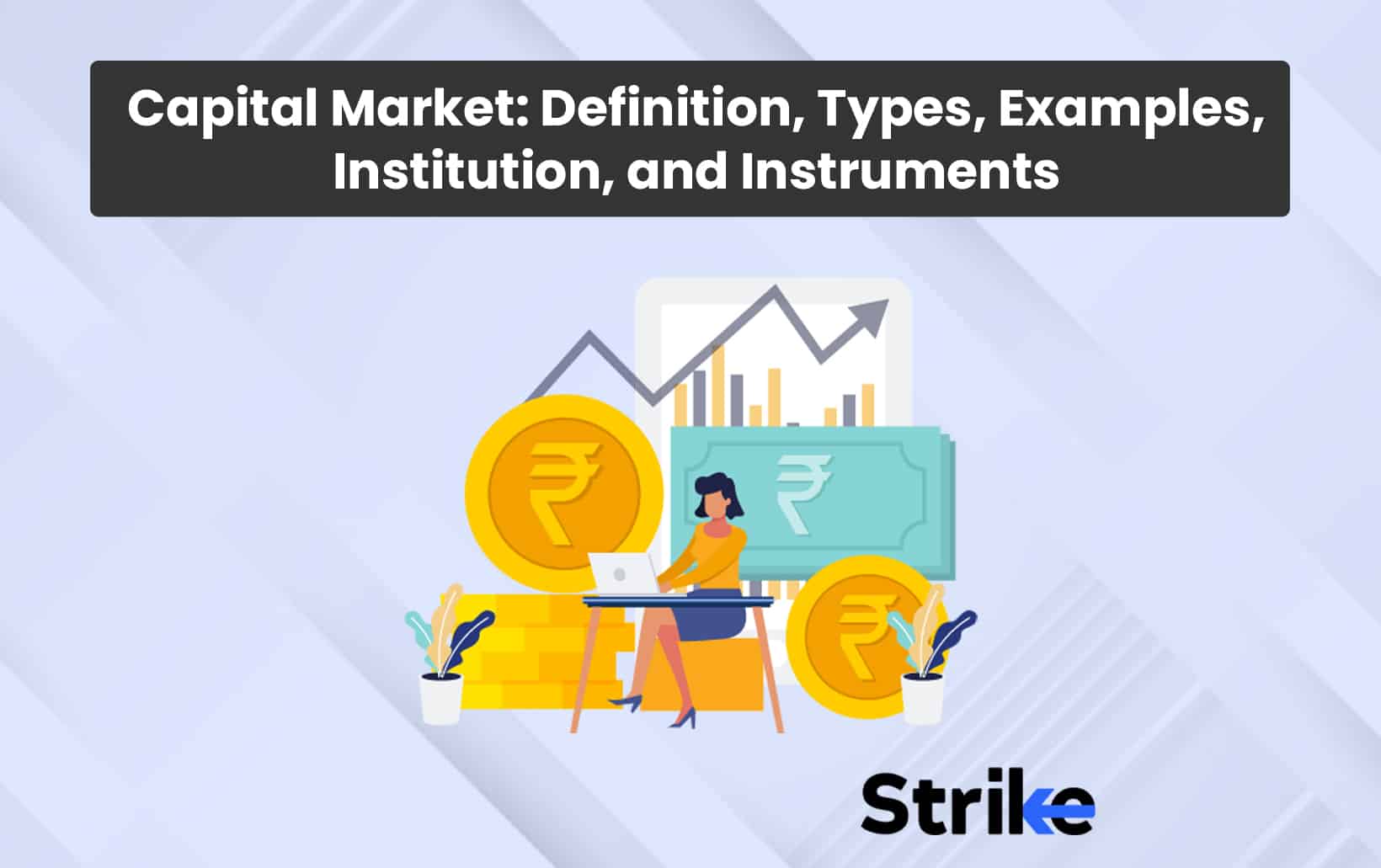
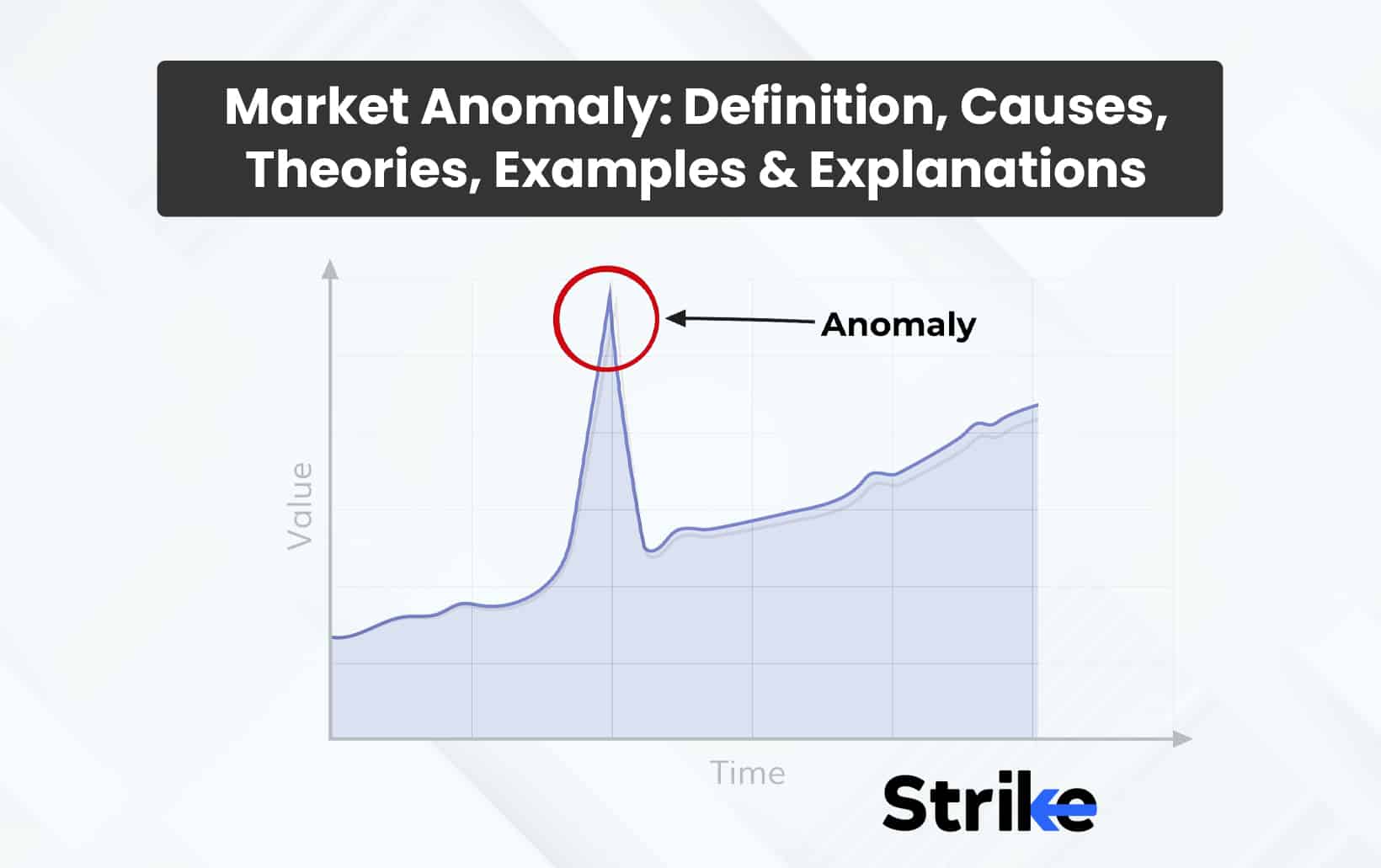

No Comments Yet